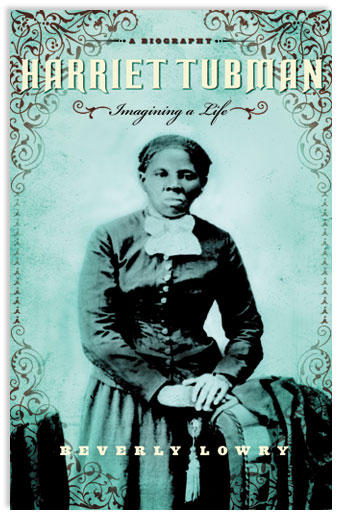Earthly Emancipator
Harriet Tubman: Imagining a Life
They called her Moses. Her given name was Araminta Ross, shortened to “Minty,” a nickname she bore until she became Harriet Tubman. It’s difficult to pinpoint when this particular shift in identity occurred. Yet there is no question that the woman who led so many of her people out of bondage had earned her biblical honorific; she regularly slid through the “wet, sucking earth” of Maryland’s Eastern Shore, evading slave catchers and watchful masters on the way to Canada, which Frederick Douglass trumpeted was “the real Canaan of the American bondsmen.” Her legendary status owed its start to her actions on the September 1849 evening of her escape, when, within earshot of her master, she signaled her impending departure by belting out the gospel chorus: “I’m bound for the promised land.”
Like Moses, Tubman knew a thing or two about snakes. He tried to use their frightening power to awe Pharaoh into letting his people go; she likened their venomous behavior to the South, hoping to convince President Lincoln that the only way to win the Civil War was to unshackle the enchained. Pressing the analogy, she urged a Massachusetts audience to imagine a large snake “curled up at her feet.” What would happen if it bit? “… everybody gets scared fearing she will die. They send for the doctor. The snake rolls back into a coil. The doctor comes and begins to cut out the bite, but the snake strikes again, in a new place this time. The doctor makes another incision. The snake strikes again. Finally someone gets wise and realizes the doctor can’t keep up with the bites and the snake is not going to stop until somebody kills it.” On the off chance this most-literate wartime president would not get the metaphor, the ever-blunt Tubman put it plainly: “Lincoln is a great man. And I’m but a poor nigger. But this nigger can tell Master Lincoln how to save money and the young men: He [can] do it by setting the niggers free.”

Biographer Beverly Lowry hopes to free Tubman, too, in this case from 19th-century hagiographers and their well-meaning, if flawed, attempts to capture Tubman’s struggles and make them their own. The appointed task is tough because Tubman was illiterate: “She could not read, never learned to write, and so of necessity, others have acted as her scribe,” Lowry writes, “each making a case for who she was, how she looked … and sounded, how she managed to do what she did … .” Discovering why Tubman acted as she did is doubly complicated by the fact that she worked alone: “Having taught herself to develop and maintain an indifferent, almost casual attitude toward circumstance-a rare skill and perhaps the real test of a genuine hero-she ran too fast to catch up with, listening only to the voices inside her head-God, she said, spoke directly to her-operating beyond sense, reason, and the boundaries of community, family, and marriage.” Under the circumstances, a writer less confident than Lowry might never have put fingers to keyboard.
Had Lowry balked, we would have been the poorer. Her Tubman is a vital, mysterious force, a dynamic presence that galvanized slaves and infuriated pro-slavery Southerners, mesmerized John Brown, and provoked northern moderates into action. Vigorous, yet prone to narcoleptic episodes resulting from a near-fatal head wound, she proved a powerful woman amid patriarchal oppression. Acting on instinct, she cut through intellectual dilemmas that knotted up so many of her contemporaries. In an era that revered the Constitution, she took the law into her own hands.
Her family was glad she did, for Tubman was responsible for their freedom, repeatedly slipping south to bring them north, brothers and sisters, nieces and nephews, mother and father-along with anyone else who showed up when Moses made her presence known by word or song. By 1858, she had emancipated upwards of 300 people, an astounding achievement given the era’s draconian legal treatment of slaves.
Yet Tubman’s most striking rescue occurred in New York state in 1860. Charles Nalle, who had escaped from Virginia two years earlier, was working around Troy when a local lawyer, learning of his fugitive status, alerted Nalle’s former owner. Under provisions of the Fugitive Slave Act (1850), Nalle remained “a slave, a runaway, a black man, and a thief.” By arresting him, U.S. Marshals ignited what the Troy Whig called “a grand state of turmoil.”
As news of Nalle’s incarceration spread, hundreds of black and white sympathizers crowded into Troy, among them Tubman, sporting a well-worn sunbonnet. The bonnet, Lowry writes, signaled to the crowd that “Moses is with them, and as long as Moses is there, Nalle is safe.”
His safety would be hard-won: As officers tried to move Nalle, Tubman tackled one of them, was clubbed down, and managed to punch out her attacker. Then she grabbed Nalle, shouting for the crowd to drag them to the river: “Drown him but don’t let them have him.” In the melee that followed, Nalle and the tenacious Tubman remain linked amid a fusillade of bullets and rocks. After several hours the crowd finally wrenched Nalle free, and Tubman guided him-as she had so many others-into a wagon that carried him to Canada.
How had Tubman, who lived nearly 200 miles away, become the central figure in this riot? It’s impossible to know, Lowry concludes, without resorting to a mythic formula in which “the savior drops down at the exact moment of greatest need, fights, conquers, vanishes.”
Tubman’s next act was just as improbable. Following Lincoln’s election, the secession of the South, and the Civil War’s initial cannonades, she headed to Beaufort, South Carolina, which had fallen to the U.S. Navy in late 1861. Tubman hoped to improve life for newly freed men and women by serving as a nurse and provisioner. She also hoped to boost military operations by operating as a spy. Within weeks she had established a food-distribution system and a network of informants, pilots, and scouts. She and her volunteers guided the Union army on forays, most notably on the daring attacks along the Combahee River. A “gallant band of 300 soldiers under the guidance of a black woman dashed into the enemies’ country,” the Wisconsin State Journal cheered, “destroying millions of dollars worth of commissary stores, cotton, and lordly dwellings, and striking terror into the heart of rebellion.” Identified only as the “Black She ‘Moses,'” Tubman earned a new sobriquet: The General.
Her warrior status is perfectly captured in the frontispiece of Sarah Bradford’s 1869 biography and reproduced in Lowry’s volume: Standing before an army encampment, wearing the now-iconic sunbonnet, a determined Tubman stares forward; her hands are gripping a rifle, its butt on the ground. She who once stole through the night to free slaves had become a black female freedom fighter marching out of the shadows to snatch America from the South’s viperlike jaws.
Lowry’s great achievement is helping us see this woman in moments glorious and grim. Less compelling is the literary technique she employs to pull this coup off. Her subtitle, “Imagining a Life,” sets the stage. As she moves among various tellings of Tubman’s experiences, interweaving her archival discoveries and critical emendations into the narrative, Lowry is confronted with the challenge of Tubman’s periodic disappearances from the historical record. Uncomfortable with such gaps, she imagines what Tubman might have been up to-what conventions she attended; with whom may she have spoken; what stores she could have patronized; what she was feeling, thinking, doing. Lowry usually gives fair warning before she diverges from what can be documented-“perhaps” is her favored signifier-as in this instance when describing Tubman’s 1900 trip from her home in Auburn, New York, to meet Sarah Bradford and the Reverend Samuel Hopkins:
Perhaps Harriet takes the Lehigh Valley train … to the Owasco Lake depot, then walks to the dock, where she will board one of the small underpowered steamboats. … Or she may simply walk the five miles from town to landing and then ride the boat. … This [latter possibility] seems likely. And so we see her on foot.
Setting aside the nagging question of who the “we” is in that final sentence (royal? inclusive?), and its imperative tone (what if “we” concoct a different scenario?), it is not clear how this discursive scene-setting enhances the reader’s comprehension of Tubman’s behavior. The same is true of Lowry’s puzzling over that day’s luncheon menu: “She likes chicken. Maybe Hopkins serves her some.”
Such distracting interjections crowd the text, deflecting our focus, and they tell us a good deal more about the biographer’s imagination than her subject’s reality. This seems an odd strategy for a writer who promised, contrary to her 19-century predecessors, “to tell the story plain.”
Contributing writer Char Miller teaches at Trinity University and is author of Gifford Pinchot and the Making of Modern Environmentalism, and Deep in the Heart of San Antonio.


